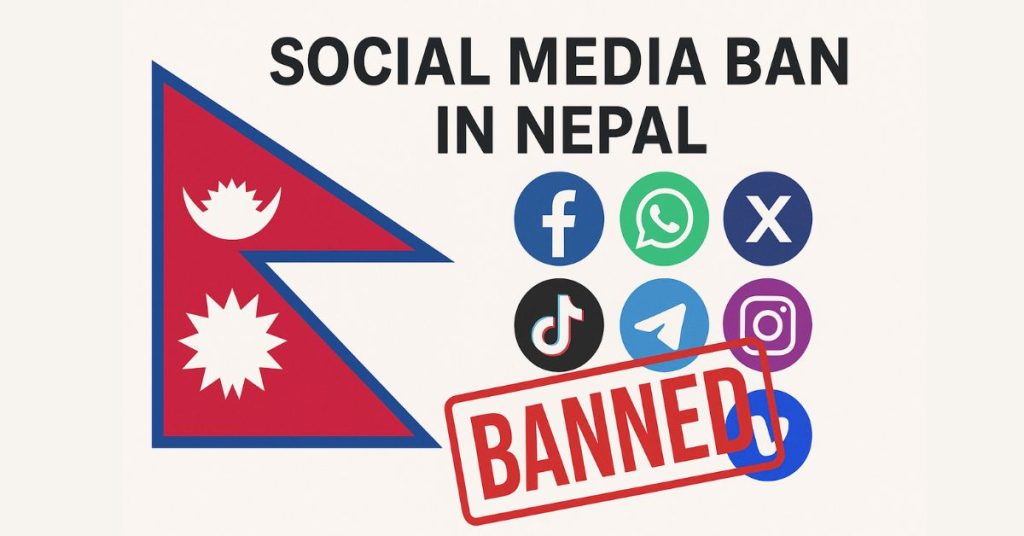On September 4, 2025, Nepal made one of its biggest moves against social media by blocking 26 major platforms. These included Facebook, Instagram, YouTube, WhatsApp, X (earlier called Twitter), and LinkedIn.
This sudden step surprised the whole country. It has affected millions of people and left many asking if the government was ready for such a decision, and what the real reasons are behind it.
The Big Question: Is this really about helping the people?
The answer is loud and clear — NOOOOOO
Methodology: Studying the Ban’s Impact
To see the real effects of this social media ban, this study uses many angles, such as:
- Different groups of people: students, businesses, IT workers, common people, and the elderly.
- Different uses of platforms: for learning, for business, and for communication.
- Money matters: how it hurts the economy right now and what it could mean in the future.
- Comparisons: looking at other countries that tried similar bans.
- Government claims vs. reality: checking what the government said against what actually happened.
Platform Categories and Their Important Uses
Professional & Educational Platforms
- LinkedIn: finding jobs, building professional contacts, growing businesses
- YouTube: learning, improving skills, tutorials, and guides
- Discord: tech groups, study circles, team projects
- Reddit: technical talks, academic help, solving problems
- Quora: sharing knowledge, expert advice, and research helps
Communication & Business Platforms
- WhatsApp, Messenger, Signal: business talks, client handling, global coordination
- Instagram, Facebook: marketing, online selling, brand growth, customer connection
- Twitter (X): quick news, real-time updates, public discussions
Creative & Income Platforms
- YouTube, Instagram, Facebook: making content, influencer income, ad earnings
- Pinterest, Tumblr: creative ideas, showing portfolios, art communities
Social & Cultural Platforms
- Snapchat, Threads, Clubhouse: youth activities, cultural sharing
- VK, Line, WeChat, Zalo: global ties, connecting diaspora communities
Impacts on Different Groups of People
1. Students
Students are one of the hardest-hit groups. Almost half of Nepal’s population is under 25, and many depend on free online tools because schools often lack resources. The ban shuts down quick access to tutorials, problem-solving forums, and global study communities.

- Without platforms, many will have to pay for private coaching, which only wealthy families can afford.
- Rural students, who already face poor internet and limited libraries, lose the little free support they had.
- The gap between rich and poor students will grow, with more dropouts in villages.
- Many young people may feel left out of global trends in science, technology, and innovation.
This could weaken Nepal’s future workforce, making it harder for the country to compete globally.
2. Business Community
The business sector faces digital isolation. For many, social media was the main way to market products and connect with customers. The ban has erased years of growth in a matter of days.

- Small shops and startups lose affordable advertising on Facebook and Instagram.
- Travel and tourism operators cannot reach foreign clients who usually book online.
- Local sellers who built digital customer bases over years are left with nothing.
- Businesses that relied on WhatsApp and Messenger for international deals face sudden breakdowns in communication.
This collapse hits small and medium businesses the hardest, as they cannot afford expensive traditional marketing.
3. IT Sector
The IT industry, one of Nepal’s rising fields, has been paralyzed. Global collaboration was the lifeline for developers and freelancers, but that has now been cut off.

- Freelancers cannot use LinkedIn to pitch work or find clients abroad.
- Developers lose access to problem-solving communities on Discord and Reddit.
- Tutorials, guides, and documentation on YouTube are no longer available.
- Startups depending on online promotion and outreach face huge setbacks.
This disruption risks making Nepali IT professionals less competitive in the global job market.
4. Content Creators
For digital creators, the ban has destroyed livelihoods overnight. Many depended on platforms for income and exposure.

- YouTube ad revenue, the main income source for thousands, has vanished.
- Instagram and Facebook sponsorships and brand deals are gone.
- Audience growth and engagement, built over the years, has collapsed.
- Creative artists have lost global reach and connections with their followers.
Entire families who depended on creator income are now in financial crisis.
5. General Population
Ordinary people feel the impact in daily life, as social media was not just entertainment but a way to stay connected and informed.
- Families with members abroad cannot communicate easily without WhatsApp or Messenger.
- Community groups for charity, local events, and emergency coordination are gone.
- News and updates reach people more slowly, allowing rumors to spread faster.
- Citizens have lost spaces to express opinions, weakening public debate.
The sudden cut-off has created a sense of disconnection and uncertainty across society.
6. Elderly
Elderly citizens may not have used every platform, but they had learned to depend on a few. Losing them has left many more isolated.

- Parents and grandparents cannot video call children and grandchildren abroad.
- Facebook groups that gave health advice or social interaction are gone.
- YouTube channels that provided religious talks, entertainment, and simple guides are no longer available.
- WhatsApp, which many seniors mastered as their main tool, has disappeared.
This leaves older people cut off from family and community support, deepening loneliness.
Government Rationale Versus Reality: A Critical Assessment
Stated Reasons for the Ban
The government justifies the social media ban based on several stated objectives:
- Preventing misuse: Addressing fake accounts, cybercrime, hate speech, and misinformation
- Regulatory compliance: Ensuring platforms follow local laws and establish grievance mechanisms
- Supreme Court directive: Implementing a court order related to a contempt of court case (Case No. 080-8-0012)
The Glaring Absence of Alternatives
Has the government acted thoughtfully for its citizens? The answer is a resounding NO.
When China built its Great Firewall, it still introduced local replacements for global platforms:
- Baidu replaced Google.
- WeChat substituted WhatsApp.
- Weibo replaced Twitter.
- Youku substituted YouTube.
- Renren replaced Facebook.
Nepal, by contrast, has offered nothing, no homegrown platforms, no backup systems, and no transition plan. Citizens are left in a digital void, cut off without tools to learn, work, or connect.
The Real Motive: Control Over Freedom
This ban is not about protecting citizens; it is about controlling them. The government’s actions point to a desire to shape information and silence opposition.

- Moderate and filter what content Nepali can see.
- Control political debates and reduce criticism.
- Block international perspectives that challenge state narratives.
- Suppress protests, dissenting voices, and activism.
- Build an information monopoly where only one side is heard.
By framing this decision as “for the people,” the government underestimates its citizens. People can see that this is not about safety, it is a direct step toward digital authoritarianism.
Long-Term Consequences for Nepal
Economic Devastation
The social media ban threatens to push Nepal backward in the global economy.
- Loss of foreign investment as companies avoid a country with poor communication channels.
- Decline in tourism as Nepal appears digitally closed and outdated.
- Brain drain, with skilled workers migrating to countries that remain connected.
- Collapse of the growing digital economy, including startups, IT services, and content creators.
Educational Regression
The education sector faces setbacks that could affect an entire generation.
- A widening gap between Nepali students and international standards.
- Reduced competitiveness in global exams, scholarships, and careers.
- Loss of free self-learning opportunities outside formal schooling.
- Rising technological illiteracy as students lose exposure to modern tools.
Social Fragmentation
Nepal risks becoming socially isolated both inside and outside its borders.
- Increased disconnection from the global community.
- Weakened ties with the Nepali diaspora, who rely on digital platforms to stay connected.
- Rising mental health issues are caused by the sudden loss of social interaction.
- Fewer opportunities for cultural exchange and learning from other societies.
Democratic Decline
The ban poses a serious threat to Nepal’s democratic values.
- Citizens lose access to diverse and independent sources of information.
- The public’s ability to organize, protest, or express dissent is restricted.
- Government accountability weakens as criticism becomes harder to voice.
- Censorship becomes normalized, creating long-term risks for freedom of speech.
Tourism Industry: International Reputation Damage
Tourism, one of Nepal’s most important industries, has been hit hard by the ban. The impact comes at a time when clear communication and online visibility are crucial.
- Communication breakdown: Hotels, guides, and agencies cannot confirm bookings or respond to emergencies quickly without WhatsApp, Messenger, or similar tools.
- Marketing disruption: Iconic experiences such as the Everest Base Camp trek or the Annapurna Circuit have lost their main promotional platforms. Online ads and social campaigns that drew global travelers are now gone.
- International perception: Nepal’s image as a welcoming, connected destination suffers. Tourists may view the country as digitally backward, leading them to choose other destinations.
Conclusion: A Digital Dark Age
The answer to whether this decision was made thoughtfully for Nepal’s citizens is a clear and emphatic NO.
The government has:
- Failed to provide alternatives: No local platforms or replacement systems were prepared.
- Ignored economic consequences: Businesses, IT workers, and content creators are left in crisis.
- Created digital isolation: Citizens are cut off from global knowledge, opportunities, and connections.
- Violated constitutional rights: Freedom of expression and access to information have been restricted without due process.
- Damaged international reputation: Nepal now appears digitally regressive at a time when global integration is vital.
Unlike China, which built domestic ecosystems like Baidu, Weibo, and Youku before restricting foreign platforms, Nepal has created only a digital vacuum. This is not protection, it is control, designed to moderate content and suppress criticism while leaving citizens powerless.
Nepal now faces the threat of a digital dark age. Education suffers, businesses collapse, workers migrate, and democracy weakens while the rest of the world moves forward.
The question is no longer whether this ban should be reversed; it is how quickly it can be undone before the damage becomes permanent. Every day the ban continues, Nepal falls further behind, its people suffer more, and the country’s future grows dimmer.
The government must act immediately to:
- Reverse the destructive ban.
- Open dialogue with students, businesses, and civil society.
- Replace blanket censorship with smart, targeted regulation.
- Invest in digital literacy instead of digital suppression.
Nepalis deserve better than isolation disguised as protection. They deserve the same rights as every global citizen to learn, to work, to speak, and to connect freely in the digital age.
A Greater Solution: Leadership and Vision
The crisis created by the social media ban is not just about digital policy; it reflects the deeper failure of Nepal’s political leadership. Citizens deserve more than reactionary decisions made without foresight or accountability.
- Old leaders and outdated parties have shown they cannot manage the challenges of the digital era.
- Nepal needs leaders with real capability, vision, and understanding of technology and global trends.
- Citizens must use their vote wisely to replace ineffective leadership with those who can build policies that empower, not isolate.
- A government chosen for its competence, not its control, is the only way forward.
Nepal’s future depends on leaders who can see beyond censorship, who value innovation, and who prioritize the growth and rights of their people. Only with capable, visionary leadership can the country move from digital isolation to digital opportunity.


